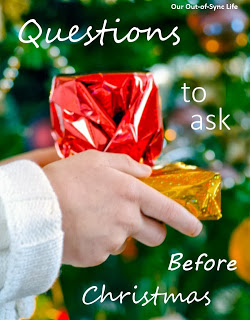 |
| source |
My kids love to open presents.
I cringe at the thought.
Sounds crazy that I wouldn’t love the experience just as much but in reality I fear the gift-opening time. What shocking statements will my children make upon seeing the objects that have been gifted to them. Especially Bubs and Little Man with all there “struggles.” So for the last few days, I have been providing each of them with scenarios before the first gift is ever set in their hands.
I can’t encourage you enough to cover these examples with your kiddos so you aren’t looking for the nearest carpet to crawl under! More importantly, activities like these teach the child social skills and respect.
To begin the role playing situation, we discuss why we receive gifts and why people give us gifts. I share how Jesus is our example. His words always contain love, self-control, kindness, and joy.
There are two rules that we have in every scenario. We never lie! We just find the positive and share it. Second, once the child is alone with Mommy or Daddy, he is free to share his disappointment in a respect way.

Here are some questions to get your started and ideas we share with our kiddos.
Let’s pretend you receive a gift that you…
1) …don’t like. What do you say?
We have trained the kids to find the positive in the gift. It could be the color, shape, size, or category. “I really like the blue on this shirt.” “This is a very big bear.” “I like to play with blocks.”
2) …already have. What do you say?
There is no need to share this unless the person asks.
3) …don’t like and the person asks you if you like it?
Stick to the positive attributes of the gift and share what you like.
4) …isn’t as cool as your brother’s gift?
This is a hard one. In this scenario we discuss being excited for others. Depending on the gift, the child may be able to use it too!
5) …love, like, dislike, or don’t like at all?
No matter how a receiver feels about a gift, he needs to have a grateful heart and express thanks to the giver. In our family this means going to the giver, looking he/she/they in the eyes, and telling them “thank you.” Depending on the relationship with the person, this includes giving he or she a hug. We practice this through role playing.
You may not agree 100% with my suggest comments. And that is okay. The point is to talk through them with your child so he or she has a toolbox of ideas when the unwrapping begins.
This doesn’t mean your child won’t be caught off guard but remember you are laying a foundation. Every step in the right direction is a step in the right direction!
And if you give my child a gift and he says “This is a nice blue color,” you will know the role playing paid off!
